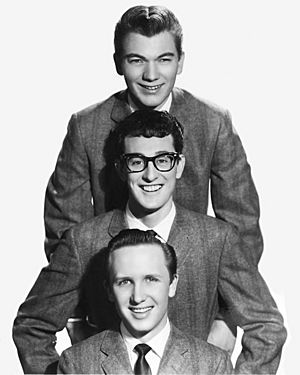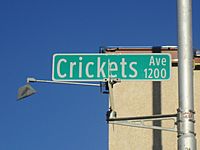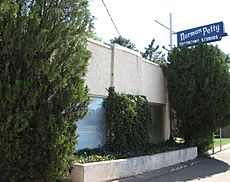The Crickets facts for kids
Quick facts for kids
The Crickets
|
|
|---|---|

|
|
| Background information | |
| Origin | Lubbock, Texas, U.S. |
| Genres | |
| Years active | 1957–2016 |
| Labels |
|
| Past members |
|
The Crickets were an American rock and roll band. They formed in Lubbock, Texas, in the 1950s. The band was started by singer-songwriter Buddy Holly. Their first big hit song was "That'll Be the Day". It came out in 1957 and reached number three on the Billboard music chart.
The Crickets' first album was called The "Chirping" Crickets. It showed the band members at that time. Buddy Holly sang lead and played lead guitar. Niki Sullivan played rhythm guitar. Jerry Allison was on drums, and Joe B. Mauldin played bass. The Crickets helped create the standard for many rock bands that came after them, like the Beatles. They used a guitar, bass, and drums lineup. They also wrote most of their own songs. After Buddy Holly's death in 1959, the band kept performing and recording. They continued with different members into the 21st century.
Contents
Band History
How the Band Started
Buddy Holly had been making practice recordings since 1954. He worked with local musician friends. Sonny Curtis, Jerry Allison, and Larry Welborn were part of these early sessions. In 1956, Holly's band was informally known as Buddy and the Two Tones. They recorded many rockabilly songs in Nashville, Tennessee, for Decca. These songs were not very successful. The band did not become famous until 1957. That's when producer Norman Petty recorded Holly's music in Clovis, New Mexico.
Holly had already recorded music under his own name for another record company. To avoid legal issues, he needed a new name for his group. The Crickets later shared how they chose their name. They were inspired by other bands named after birds. They thought about names based on insects. They almost picked the name Beetles. Years later, the Beatles chose their name partly to honor The Crickets.
The original Crickets were Buddy Holly (lead guitar and singer), Jerry Allison (drums), Joe B. Mauldin (bass guitar), and Niki Sullivan (rhythm guitar). Sullivan left the band after about a year to go back to school. The Crickets then became a trio. They continued to perform on stage and TV. They also recorded more songs, many of which they wrote themselves.
Early Success and Changes
In 1957, producer Norman Petty decided to release The Crickets' songs under two different names. Songs with Buddy Holly singing alone were released as "Buddy Holly." Songs with backing vocals were released as "The Crickets." Petty thought that radio DJs might not play too many songs by one artist. But they would play songs by two different-sounding groups. Some DJs called the band "Buddy Holly and the Crickets." However, the record labels did not use this name until after Holly passed away.
In 1958, Holly stopped working with producer Petty. He moved to New York to be more involved in the music business. Allison and Mauldin decided not to move and went back to Lubbock. Holly then recorded under his own name. He worked with studio musicians like Tommy Allsup and Carl Bunch. Waylon Jennings also toured with him later.
Allison and Mauldin planned to rejoin Holly after his winter tour. Meanwhile, Mauldin, Allison, and Sonny Curtis (a friend of Holly's) started recording new songs as The Crickets. Earl Sinks sang lead vocals. While they were recording, news came that Holly had died in a plane crash during his tour.
The Crickets After Buddy Holly
The Crickets continued to perform after Buddy Holly's death. Earl Sinks was their vocalist at this time. David Box, who sounded like Holly, joined the group for a 1960 song. This song was "Dont Cha Know"/"Peggy Sue Got Married". Box left the group in 1960 and later died in a plane crash in 1964.
In April 1960, The Crickets played as the backing band for the Everly Brothers on their first UK tour. By 1962, The Crickets included Sonny Curtis, Jerry Allison, Glen D. Hardin, and Jerry Naylor. That year, their song "Don't Ever Change" reached the top five in the British charts. Bobby Vee also sang with them on their 1962 album Bobby Vee Meets the Crickets.
In 1963, The Crickets had two more songs in the UK top 40. These were "My Little Girl" and "Don't Try to Change Me." These were their last songs to reach the charts. The band kept recording new music. In 1964, they released their version of the surf rock song "California Sun".
Over the years, the band had many member changes. However, Sonny Curtis and Jerry Allison were often part of the group. For their 1971 album, the band included Curtis, Allison, and Doug Gilmore. In 1973, the lineup featured Curtis, Allison, Hardin, and bassist Ric Grech.
In 1978, a movie called The Buddy Holly Story came out. It starred Gary Busey as Buddy Holly. The movie was entertaining but not fully accurate about the band's early days. The names of Allison and Mauldin were changed in the film. The Crickets liked the movie overall, but Jerry Allison was upset by how his character was shown.
The Crickets in the 21st Century

In 2004, The Crickets released an album called The Crickets and Their Buddies. It featured classic songs from their career. Many famous artists performed on the album. These included Eric Clapton, Rodney Crowell, Waylon Jennings, and Graham Nash. For this album, The Crickets were officially Allison, Curtis, and Mauldin. Former members Albert Lee and Glen D. Hardin also played.
On October 28, 2008, The Crickets were honored. They were inducted into the Musicians Hall of Fame and Museum in Nashville, Tennessee. They played "Peggy Sue", "Not Fade Away", and "That'll Be the Day" at the ceremony. Keith Richards joined them on guitar.
In 2011, Jerry Allison was still touring. He performed with Sonny Curtis, who sang and played guitar. Curtis was a childhood friend and bandmate of Buddy Holly.
On April 14, 2012, The Crickets were inducted into the Rock and Roll Hall of Fame. A special committee made sure the band was included. Buddy Holly had been inducted alone in 1986. The inducted members were Jerry Allison, Sonny Curtis, Joe B. Mauldin, and Niki Sullivan. The group could not attend the ceremony because Mauldin was ill.
Joe B. Mauldin passed away from cancer on February 7, 2015. He died in Nashville, Tennessee.
On February 6, 2016, "The Crickets & Buddies" performed in Clear Lake, Iowa. This was at the Surf Ballroom, where Buddy Holly had his last show. Members from different Crickets lineups appeared. These included Sonny Curtis, Glen D. Hardin, Albert Lee, and Tommy Allsup. After this show, Jerry Allison announced that it was the group's final performance.
Band Members Over Time
- Jerry Allison – drums (1957–2016)
- Buddy Holly – lead vocals, guitar (1957–1958, died 1959)
- Joe B. Mauldin – bass (1957–1960, 1976–2015; his death)
- Niki Sullivan – guitar (1957–1958, died 2004)
- Sonny Curtis – guitar (1958–1960, 1962–1985, 1994–2016); lead vocals (1962–1985, 1994–2016)
- Earl Sinks – lead vocals (1958–1960, died 2017)
- Tommy Allsup – guitar (1959, died 2017)
- Jerry Naylor – lead vocals (1961–1964, died 2019)
- Glen Hardin – keyboards (1962–1972, 1999–2016); keyboard bass (2015–2016)
- Gordon Payne – lead vocals, guitar (1985–1994)
See also
 In Spanish: The Crickets para niños
In Spanish: The Crickets para niños




